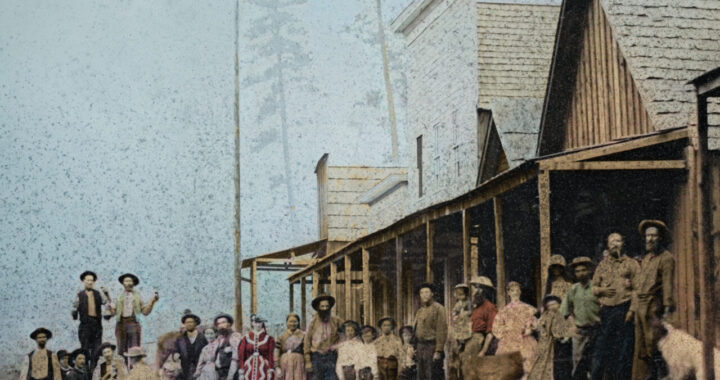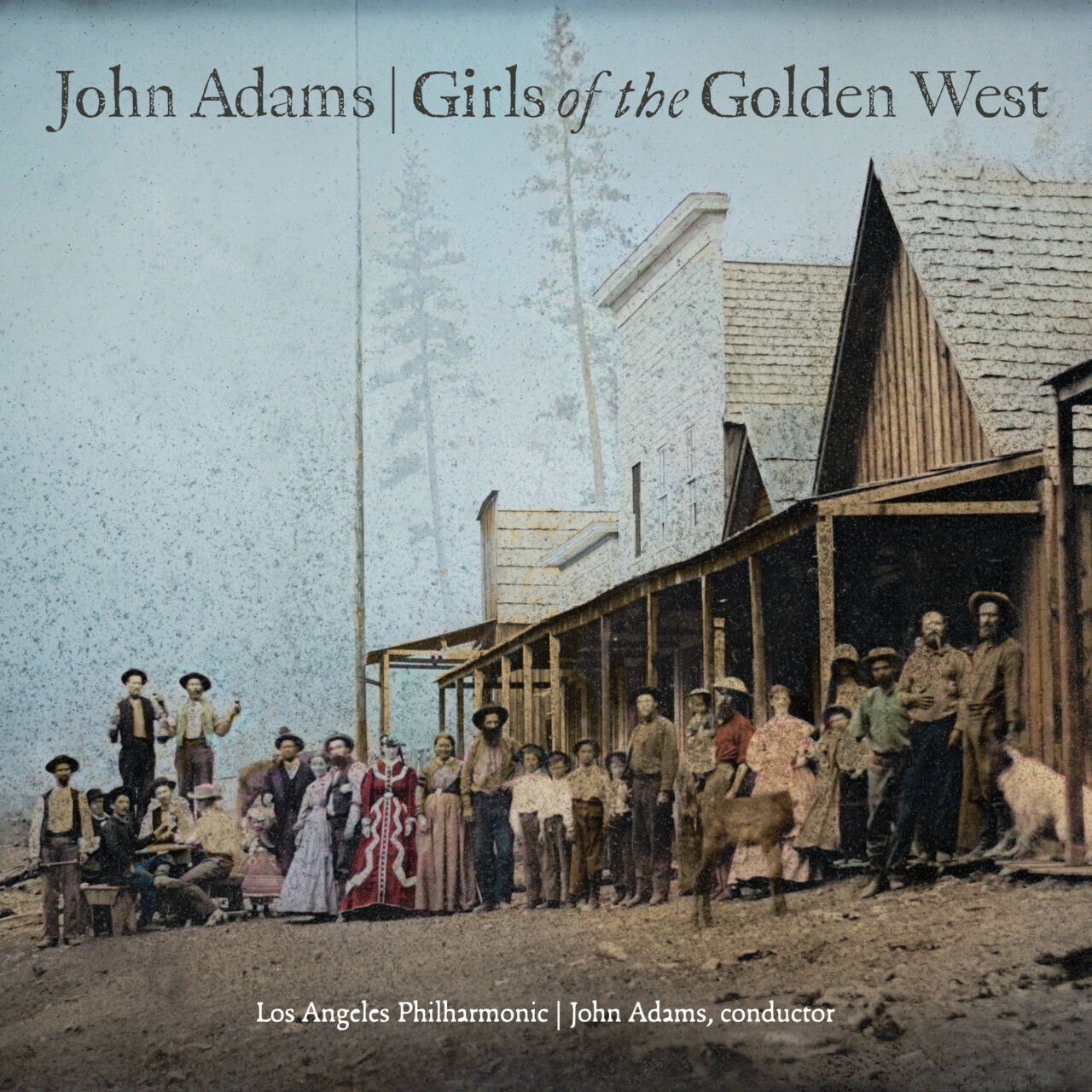‘Girls of the Golden West’ is the eighth musical theater work by John Adams (b. 1947) to be released on Nonesuch Records. Adams’ stage works are among the most widely performed operas of our time, including ‘Nixon in China’, ‘The Death of Klinghoffer’, ‘El Niño’, and ‘Doctor Atomic’.
‘Girls of the Golden West’ is a California opera that tells the story of the Gold Rush not through the familiar myths, but through the words and deeds of real people, once described by Mark Twain as “the strangest population, the finest population … who ever trooped down the startled solitudes of an unpeopled land.”
The opera is based on the letters of Louise Clappe, written in the Rich Bar mining camp on the Feather River during the California Gold Rush and published in 1851/1852 under the pseudonym Dame Shirley. The libretto was also inspired by other literature of the time, including newspaper articles and writings by Mark Twain. John Adams was honored to present the real voices of these people, whether from their letters, songs, or newspaper articles.
The California Gold Rush began on January 24, 1848, when James W. Marshall discovered gold at Sutter’s Mill in Coloma, California. News of the discovery drew some 300,000 people from across America and beyond to California. The huge amount of gold found created an economic boom in the United States. The rapid population growth eventually led to California’s statehood in the Compromise of 1850.
Unfortunately, the effects of the gold rush also had a negative side. Native communities were attacked and forced off their land by the prospectors, known as the “Forty-Niners” because 1849 was the peak year of immigration.
Director Peter Sellars conceived the libretto while researching a 1910 production of Puccini’s opera ‘La fanciulla del West’, also about the gold rush. He describes the stories of the Forty-Niners as heroic, passionate, and brutal, with themes of racial conflict, colorful heroics, and the struggle to build new lives and define what it means to be American.
Following its 2017 San Francisco premiere and a production at De Nederlandse Opera, Adams has significantly reworked the opera into a new, dramatically more compact version.
The composer leads the Los Angeles Philharmonic in this recording from Walt Disney Concert Hall.
High Art Music and Low Pop Sounds
John Adams grew up in New Hampshire in a household that listened to Mozart as well as Benny Goodman. This openness to all kinds of music, American and European, old and new, “high” art music and “low” pop sounds, also set him apart as a composer.
As a child, he played clarinet, conducted a small country orchestra, and wrote his first piece of music. He studied at Harvard and was introduced to John Cage’s book ‘Silence: Lectures and Writings’. The latter hit Adams like a “bomb”. Suddenly there were viable alternatives to the constraints of serial music, the dogmatic twelve-tone music of Schoenberg and Webern, and later Boulez. To explore these possibilities, Adams moved to the West Coast in 1971, to San Francisco.
In the early 1970s, the young composer came into contact with minimal music. In it, he found a solution to the musical dilemmas he was struggling with. At the time, Adams called minimalism “the only really interesting and important stylistic development of the last forty years.”
At the same time, it should be noted that John Adams took minimalism in a very different direction than, say, Philip Glass and Steve Reich, to name the movement’s two best-known composers. Far less concerned with non-Western music than those two, Adams put his minimal music in the service of an essentially more emotional and purposeful musical language. He rejected the mechanical, very pure but impersonal approach of minimalism, especially as it was practiced in the beginning. Adams simply wanted more drama in his music. Or rather, he wanted to connect music to everyday life.
John Adams met director Peter Sellars, known for his unorthodox and idiosyncratic approach to theater. Sellars suggested that he create an opera about the historic 1972 meeting between Richard Nixon and Mao Tse Tung. Adams agreed. ‘Nixon in China’ (1987) became not a satire, as so many had thought and perhaps hoped, but an empathetic, almost heroic narrative about an event that continues to influence international relations today. A second opera, ‘The Death of Klinghoffer’ (1990), dealt with the Palestinian-Israeli conflict and drew heavily on Bach in its emotional approach, particularly his settings of the Biblical Passion. The exuberant post-minimalist cascades of sound that rippled off the stage in ‘Nixon’ had given way to a dark and dissonant sound.
In 1995, Adams and Sellars collaborated with poet June Jordan to create the musical theater piece ‘I Was Looking at the Ceiling and Then I Saw the Sky’, an “earthquake romance”, in their words, modeled on Bertolt Brecht and Kurt Weil’’s ‘Dreigroschenoper’.
“the strangest population, the finest population … who ever trooped down the startled solitudes of an unpeopled land”
Bertolt Brecht and Kurt Weill are also the first references that come to mind when listening to ‘Girls of the Golden West’. Especially ‘Scene 2 – My name is Joe’ as interpreted by tenor Paul Appleby could easily find a place in ‘The Rise and Fall of Mahagonny’. But so could characters like ‘Hustler Ned Peters’, ‘The Gambler’ and the prostitute ‘Ah Sing’.
‘Girls of the Golden West’ is performed by the Los Angeles Master Chorale and a talented cast including the aforementioned Paul Appleby, Julia Bullock, Davóne Tines, Hye Jung Lee, Elliot Madore, Daniela Mack and Ryan McKinny.
According to Adams, ‘Girls of the Golden West’ is perhaps the most personal of all his stage works. Adams: “As something of an immigrant from California who, like the characters in the story, has hiked the same mountains for forty years, I share the sense of awe and appreciation for the magnificence and the ‘never-enough-to-be-talked-about sky of California’ that Dame Shirley (soprano Julia Bullock – CCE) manages to convey so perfectly in the opera’s final moment.”
In the score, the composer emphasizes both the mocking and sentimental characteristics of the old gold rush songs. During the gold rush, miners sang these lyrics to the familiar melodies of Stephen Foster classics such as ‘Camptown Races’ or ‘Oh! Susanna’. The composer set the often lively and colorful lyrics to his own music, sung by a male chorus, to give the opera energy.
And energy it has, ‘Girls of the Golden West’, both in the drama and in the visual overtones of the music. It splashes in the minimal rivers of sound that flowed earlier in ‘Nixon in China’ and other Adams works, as well as in the burlesque mix of theatrical music, popular songs and opera in which chorus and orchestra make the ‘Golden West’ smoke and catch fire in an explosion of unrelenting urges to live and courage. Especially the latter. If ‘Girls of the Golden West’ is anything, it is a tribute to the courage to go on of “the strangest population, the finest population … who ever trooped down the startled solitudes of an unpeopled land.”
John Adams – Girls of the Golden West (Nonesuch)


